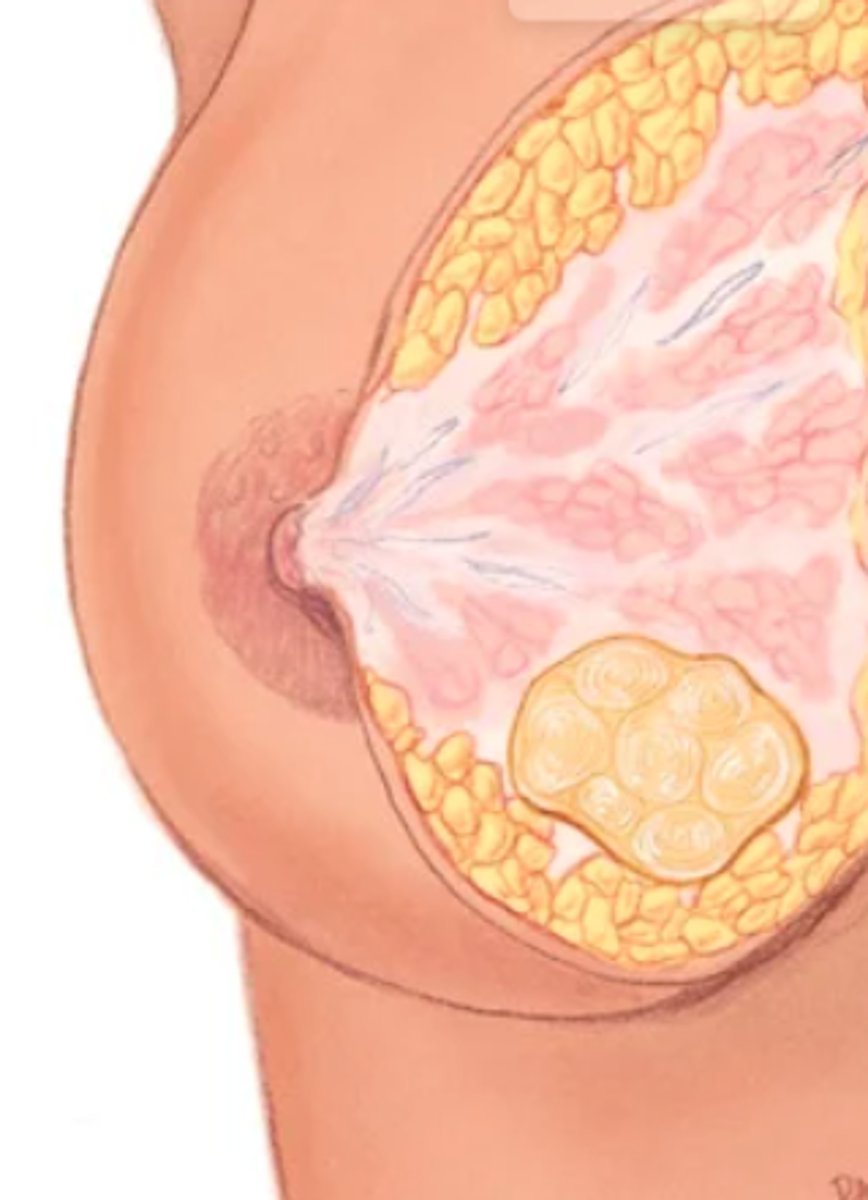Breasts, Axillae, and Regional Lymphatics
1/36
There's no tags or description
Looks like no tags are added yet.
Name | Mastery | Learn | Test | Matching | Spaced |
|---|
No study sessions yet.
37 Terms
breast health care access
_________ is influenced by income, health insurance, geographic, cultural and language barriers, and racial bias.
breast cancer
is influenced by
- BRCA1 and BRCA2
- age and ethnicity
- use of combined HRT
- lifestyle risk factors
40
annual mammography starting at age _____
risk factors for breast cancer
• Age (65+)
• BRCA1 and/or BRCA2
• Mammographically dense breasts
• Personal history of breast cancer (esp. early)
• First-degree relatives with breast cancer diagnosed at a nearly age
• Postmenopausal
• High-dose radiation to chest
• No pregnancies or late pregnancy
• No breast feeding
• Ashkenazi heritage
Teach Breast Self-Examination (BSE)
an example of health promotion for breast cancer is?
Teach Breast Self-Examination (BSE)
Help each woman establish regular schedule of self-care.
The best time to conduct BSE is right after menstrual period, when breasts are smallest and least congested.
- Stress that self-examination will familiarize woman with her own breasts and their normal variation; emphasize absence of lumps (not the presence of them).
- Encourage her to report any unusual finding promptly.
general appearance of breasts
Note symmetry of size and shape It is common to have a slight asymmetry in size; often the left breast is slightly larger than the right.
nipples
should be placed symmetrically on the same plane on the two breasts, they usually protrude, although some are flat and some are inverted. They tend to stay in their original condition.
abnormal
a recently retracted nipple from one that has been inverted for many years is considered _____
true
true or false: Normal nipple inversion may be unilateral or bilateral and usually can be pulled out
abnormal
any dry scaling, fissure or ulceration, and bleeding or other discharge in the nipple is considered
supernumerary nipple
is a normal and common variation.
- An extra nipple along the embryonic "milk line" on the thorax or abdomen is a congenital finding.
- Usually it is 5 to 6 cm below the breast near the midline and has no associated glandular tissue.
-It looks like a mole, although a close look reveals a tiny nipple and areola. It is not significant; merely distinguish it from a mole.
symmetrically
maneuvers to screen for retraction
- Direct the woman to change position while you check the breasts for skin retraction signs. First ask her to lift her arms slowly over her head. Both breasts should move up ______
retraction signs
are caused by fibrosis in the breast tissue, usually caused by growing neoplasms. The fibrosis shortens with time, causing contrasting signs with the normally loose breast tissue.
Note a lag in the movement of one breast.
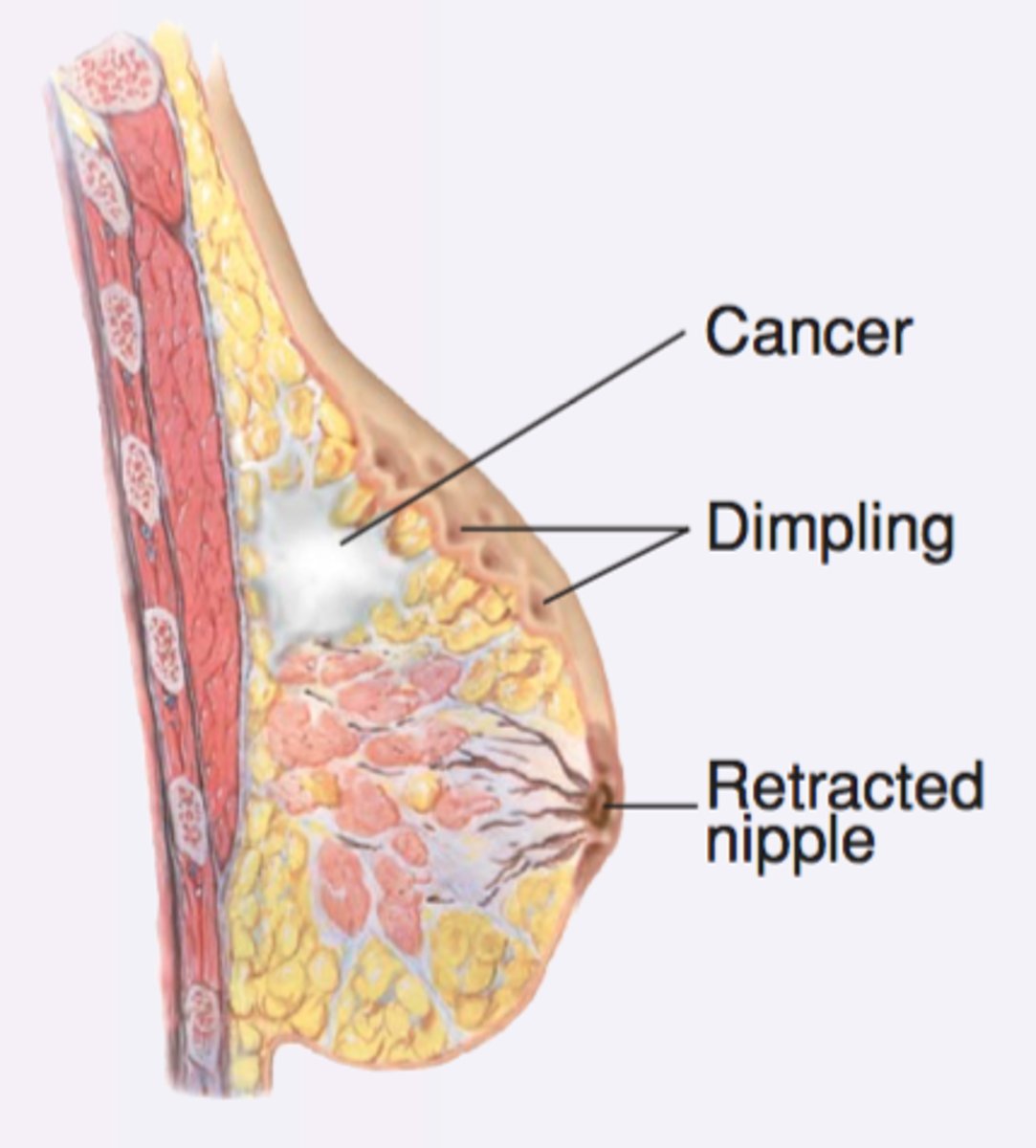
asking patient to push her hands on her hip
what maneuver contracts the pectoralis major muscle and a slight lifting of both breasts should occur
- Note a dimpling or a pucker, which indicates skin retraction
symmetric free-forward movement
Ask the woman with large, pendulous breasts to lean forward while you support her forearms. Note the _______ of both breasts
- Note fixation to chest wall or skin retraction
four
Examine the axillae while the woman is sitting.
- Inspect the skin, noting any rash or infection. Lift the woman's arm and support it yourself so her muscles are loose and relaxed. Use your right hand to palpate the left axilla Reach your fingers high into the axilla. Move them firmly down in _______ directions
four directions when palpating the axillae
- down the chest wall in a line from the middle of the axilla,
- along the anterior border of the axilla,
- along the posterior border
- along the inner aspect of the upper arm.
Move the woman's arm through range of motion to increase the surface area that you can reach.
axilla lymph nodes
Usually nodes are not palpable, although you may feel a small, soft, nontender node in the central group. Expect some tenderness when palpating high in the _____. Note any enlarged and tender lymph nodes.
raised over their head
when palpating the breast it's important to have the patient's are _______
- this flattens the breast tissue and displaces it medially
- Any significant lumps then feel more distinct
pendulous
For_____ breasts, to distribute the tissue medially across the chest wall, ask the woman to rotate her hips opposite to the side you are palpating.
3
when palpating the breast use the pads of your first _____ fingers and make a gentle rotary motion on the breast. Vary your pressure so you are palpating light, medium, and deep tissue in each location.
vertical strip pattern
is the best way to detect a breast mass, but two other patterns are in common use: from the nipple palpating out to the periphery as if following spokes on a wheel and palpating in concentric circles out to the periphery.
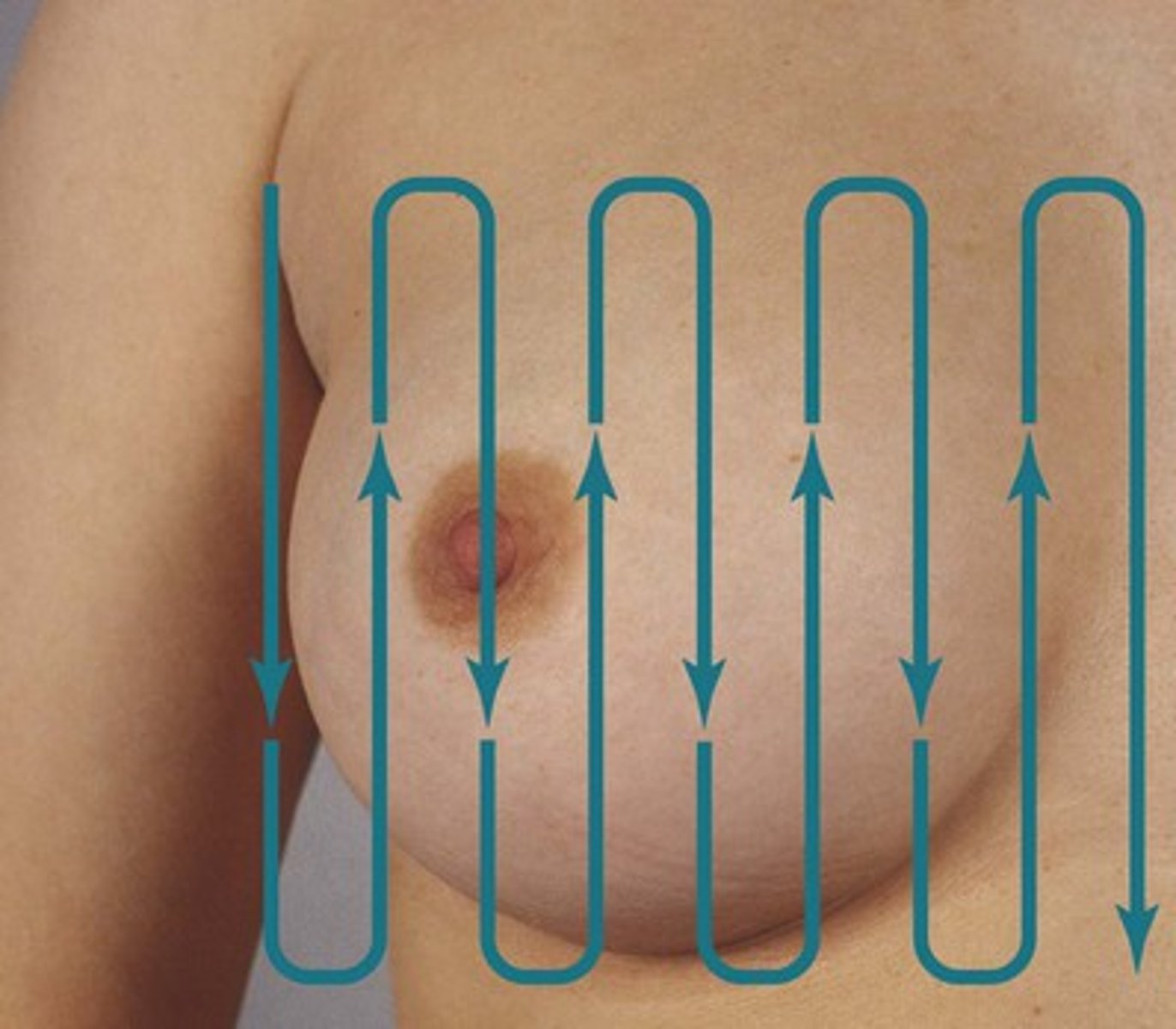
vertical strip pattern
start high in the axilla and palpate down the midaxillary line just lateral to the breast down to the bra line.
-Proceed medially in overlapping vertical lines ending at the sternal edge.
- Take care to palpate every square inch of the breast and examine the tail of Spence high into the axilla.
- This should take a few minutes with each breast. Be consistent and thorough in your approach to each woman.
normal breast tissue
In nulliparous women normal breast tissue feels firm, smooth, and elastic. After pregnancy the tissue feels softer and looser.
- Premenstrual engorgement is normal from increasing progesterone. This consists of slight enlargement, tenderness to palpation, and generalized nodularity; the lobes feel prominent, and their margins more distinct.
inflammation
Heat, redness, and swelling in non lactating and non postpartum breasts indicate _____
inframammary ridge
a firm transverse ridge of breast tissue in the lower quadrants
- it is especially noticeable in large breasts
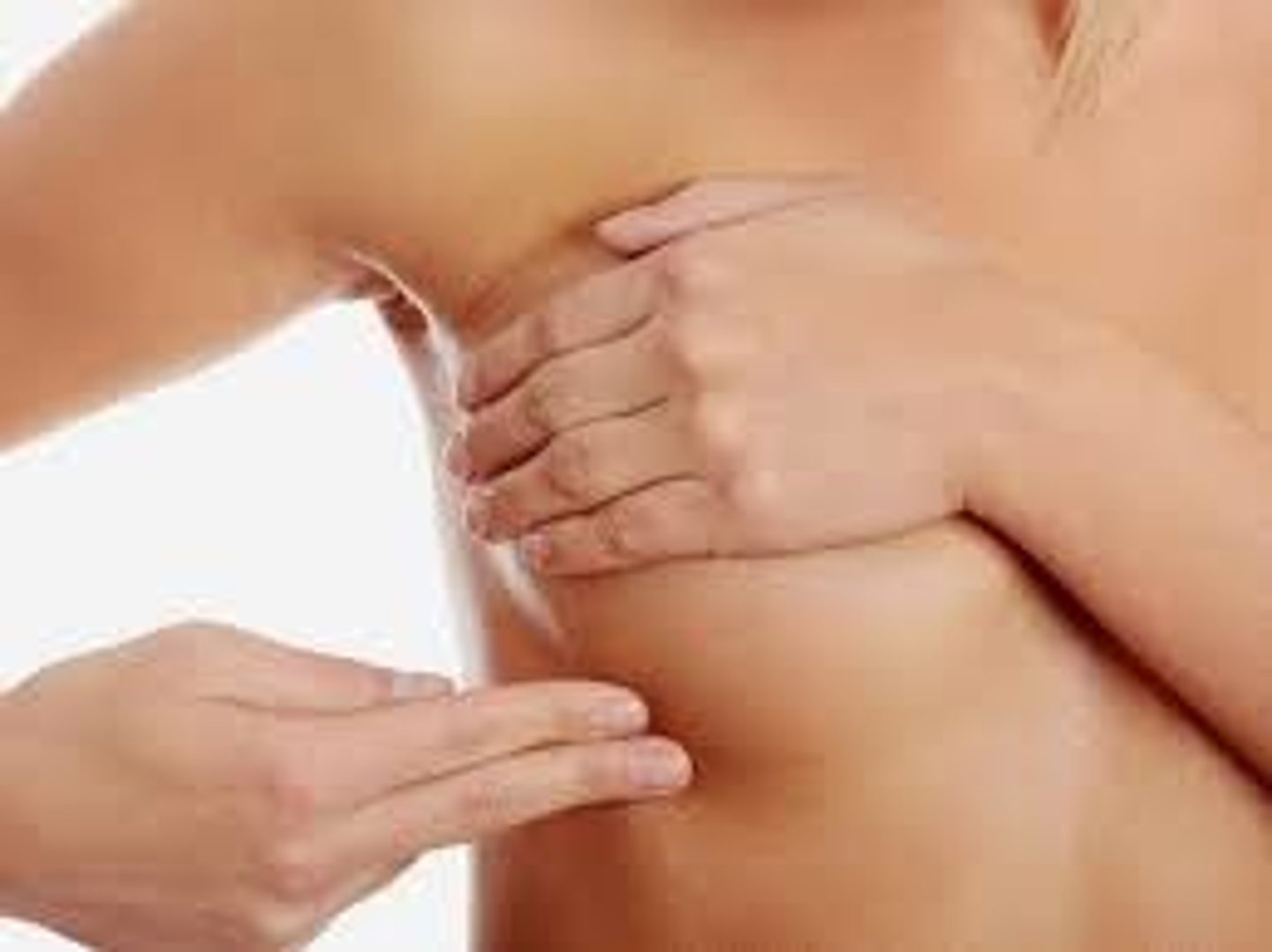
anterior thorax test
when palpating the male breast you should combine it with the ______
- Inspect the chest wall, noting the skin surface and any lumps or swelling.
- Palpate the nipple area for any lump or tissue enlargement
- It should feel even, with no nodules. Palpate the axillary lymph nodes.
gynecomastia
is a benign growth of this breast tissue, making it distinguishable from the other tissues in the chest wall. It feels like a smooth, firm, movable subareolar fibrous mass
- occurs with use of anabolic steroids, some medications, cirrhosis, and other diseases.
one half of adolescent boys (13-14)
gynecomastia often occurs in about
true
true or false: The normal male breast has a flat disk of undeveloped breast tissue beneath the nipple
benign breast disease, invasive cancer, fibroadenoma
what are three types of breast lumps?
benign (fibrocystic) breast disease
Multiple tender masses that occur with numerous symptoms and physical findings: (1) swelling and tenderness (cyclic discomfort), (2) nodularity (significant lumpiness, both cyclic and noncyclic), (3) dominant lumps (including cysts and fibroadenomas), (4) nipple discharge (including intraductal papilloma and duct ectasia), and (5) infections and inflammations.
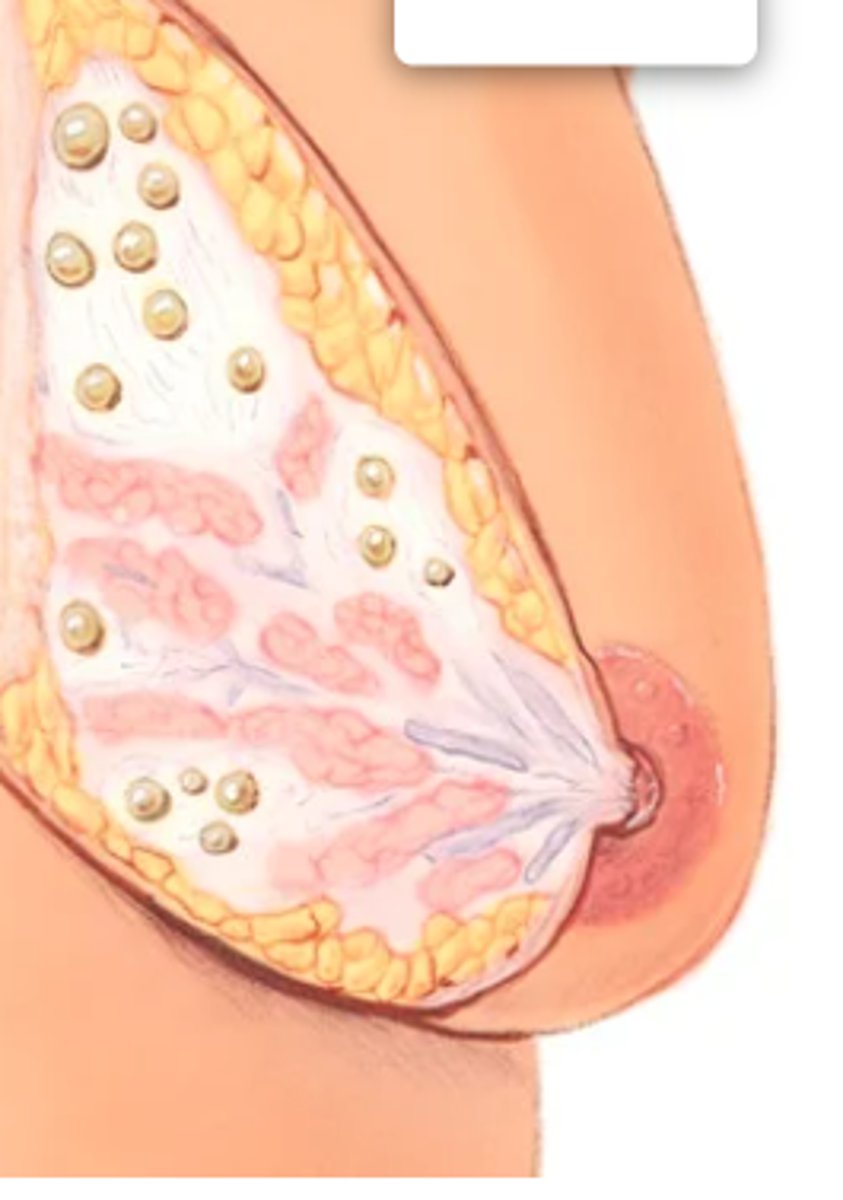
true
true or false: Some women have nodularity but no pain
Nodularity; Cysts
Many women have some form of benign breast disease.
- _______ occurs bilaterally; regular, firm nodules are mobile, well demarcated, and feel rubbery like small water balloons.
- Pain may be dull, heavy, and cyclic as nodules enlarge.
- _______ are discrete, fluid-filled sacs. Nonproliferative conditions have little to no increased cancer risk.
- The atypical hyperplasia forms do increase the risk of breast cancer.
invasive cancer
Cancers that spread into surrounding breast tissue.
- May present as a solitary, unilateral, 3-dimensional, usually nontender mass.
- Solid, stony, hard, dense, and fixed to underlying tissues or skin as cancer becomes invasive.
- Borders are irregular and poorly delineated. Grows constantly. Requires diagnostic mammogram for those over age 30 years and at average risk.
- Found in those 30 to 80 years of age; increased risk across all ages until age 80 years.
- As cancer advances, signs include firm or hard irregular axillary nodes; skin dimpling; nipple retraction, elevation, and discharge.
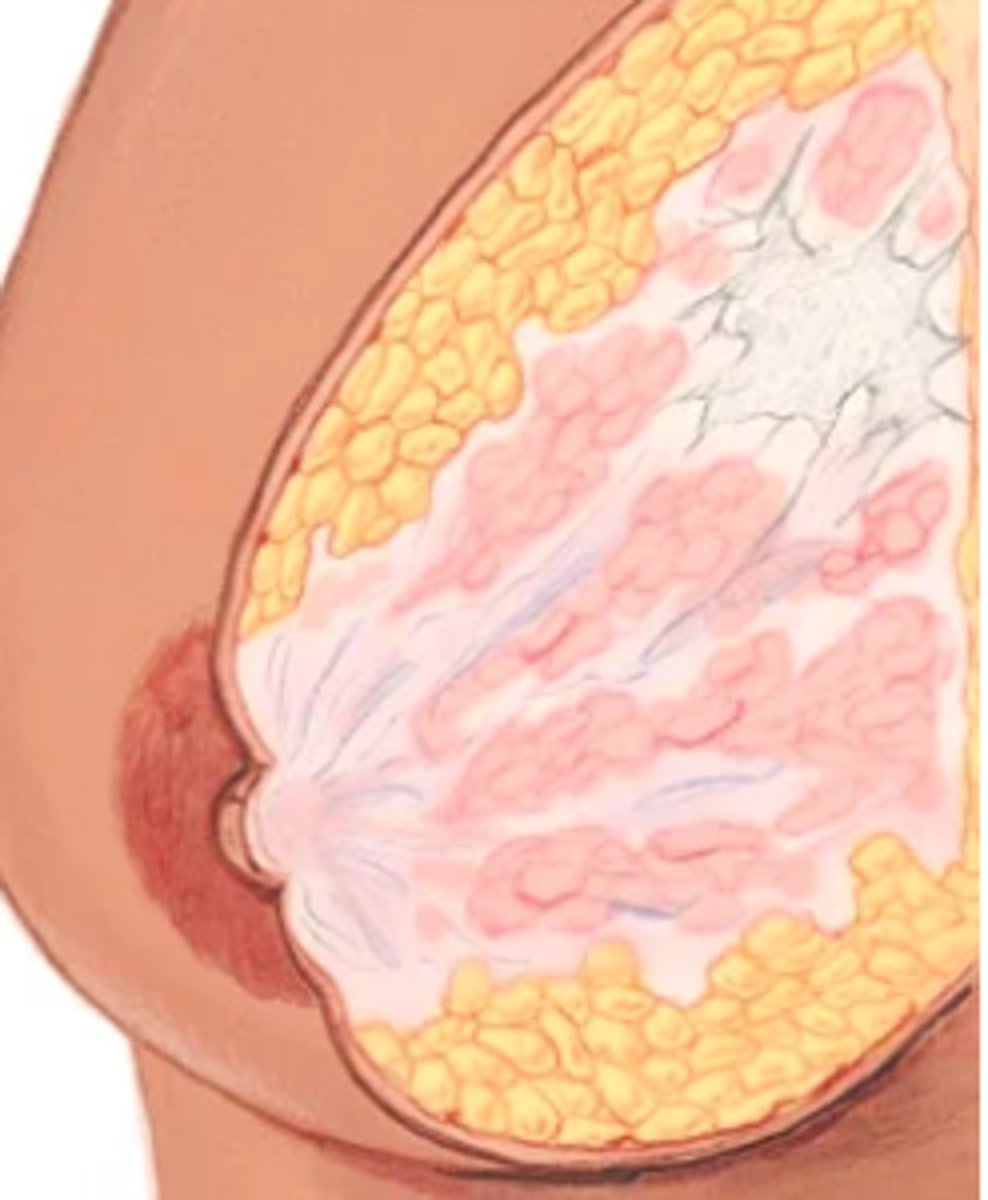
fibroadenoma
Benign mass, most commonly self-detected in late adolescence and early adulthood.
-Solitary nontender mass that is solid, firm, rubbery, and elastic.
- Round, oval, or lobulated; 1 to 5 cm; clear margins.
- Freely movable, slippery; fingers slide it easily through tissue.
- Usually no axillary lymphadenopathy but frequently painful.
- May resolve spontaneously in those younger than 20 years.
-Diagnose by palpation, ultrasound, and needle biopsy.
-Because of risk of deformity of surgery to a growing breast, excisional surgery is reserved for masses >5 cm; for continuously enlarging, well-circumscribed, multiple masses; or with suspicious ultrasound findings.
